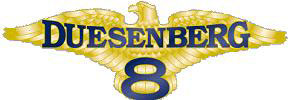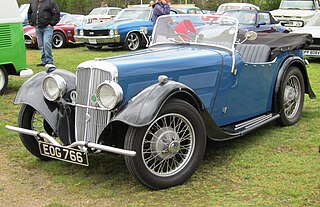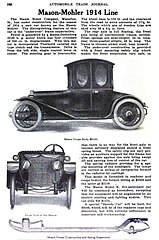
Marathon Motor Works was a brass era automobile manufacturer based in Tennessee. Southern Engine and Boiler Works founded in 1889, which made industrial engines and boilers in Jackson, Tennessee, established the factory in 1907. From 1909 to 1914, the company manufactured the Marathon automobile in Nashville, Tennessee.

Duesenberg Automobile & Motors Company, Inc. was an American racing and luxury automobile manufacturer founded in Indianapolis, Indiana, by brothers Fred and August Duesenberg in 1920. The company is known for popularizing the straight-eight engine and four-wheel hydraulic brakes. A Duesenberg car was the first American car to win a Grand Prix race, winning the 1921 French Grand Prix. Duesenbergs won the Indianapolis 500 in 1922, 1924, 1925 and 1927. Transportation executive Errett Lobban Cord acquired the Duesenberg corporation in 1926. The company was sold and dissolved in 1937.

Elmore Manufacturing Company was a manufacturer of veteran and brass era automobiles and bicycles (1893–97), headquartered at 504 Amanda Street, Clyde, Ohio, from 1893 until 1912. The company took its name from a small parcel of land in Clyde with the name Elmore associated with it where a stave mill was established originally, then evolved into bicycle production. The village of Elmore, Ohio is located 20 mi (32.2 km) to the east. Founded by Harmon Von Vechten Becker and his two sons, James and Burton, the Elmore used a two-stroke engine design, in straight twin or single-cylinder versions. They later produced a straight-3 followed by a straight-4 beginning in 1906 until production ended in 1912. The company advertising slogan was "The Car That Has No Valves", referring to the two-stroke engine.

The Knox Automobile Company was a manufacturer of automobiles in Springfield, Massachusetts, United States, between 1900 and 1914. Knox also built trucks and farm tractors until 1924. They are notable for building the very first modern fire engine in 1905, and the first American vehicle with hydraulic brakes, in 1915.

Royal Motor Car Company was a Brass Era manufacturer of luxury automobiles in Cleveland, Ohio, in business from 1904 to 1911. It was the result of a reorganization of the Hoffman Automobile Company.

Stevens-Duryea was an American manufacturer of Veteran and Brass Era automobiles in Chicopee Falls, Massachusetts, between 1901 and 1915 and Vintage Cars from 1919 to 1927.

The Premier Motor Manufacturing Company built the brass era and vintage Premier luxury automobile in Indianapolis, Indiana, from 1903 to 1925.

The Marion was an automobile produced by the Marion Motor Car Company in Indianapolis, Indiana from 1904 to 1915.

Frederick Samuel Duesenberg was a German-born American automobile and engine designer, manufacturer and sportsman who was internationally known as a designer of racecars and racing engines. Duesenberg's engineering expertise influenced the development of the automobile, especially during the 1910s and 1920s. He is credited with introducing an eight-cylinder engine, also known as the Duesenberg Straight-8 engine, and four-wheel hydraulic brakes, a first for American cars, in addition to other mechanical innovations. Duesenberg was also patentholder of his designs for a four-wheel hydraulic brake, an early automatic transmission, and a cooling system, among others. Fred and his younger brother, August "Augie" Duesenberg, shared the patents, filed in 1913 and renewed in 1918, for their "walking beam" four-cylinder engine and the Duesenberg Straight 8.

August Samuel Duesenberg was a German-born American automobile and engine manufacturer who built American racing and racing engines that set speed records at Daytona Beach, Florida, in 1920; won the French Grand Prix in 1921; and won Indianapolis 500-mile races, as well as setting one-hour and 24-hour speed records on the Bonneville Salt Flats in Utah in 1935. He also shared with his older brother, Frederick S. "Fred" Duesenberg, patents filed in 1913 and renewed in 1918 for a four-cylinder engine design and the Duesenberg Straight 8.

Barley Motor Car Co. was a manufacturer of luxury automobiles in Kalamazoo, Michigan, and Streator, Illinois. It manufactured the Roamer automobile (1916–29) and briefly, the Barley (1922–24), and the Pennant (1924–25).

The Staver and Staver-Chicago was an American Brass Era automobile manufactured at 76th and Wallace Streets in Chicago, Illinois, by the Staver Carriage Company from 1906 until 1914.

Luverne was the marque of the Luverne Automobile Company, which produced automobiles from 1904 to 1917 in Luverne, Minnesota.

The Moline Automobile Company, was an American brass era automobile manufacturer in East Moline, Illinois known for the Moline, Dreadnought Moline,Moline-Knight and R & V Knight marques.

The Matheson was a luxury American automobile manufactured from 1903 to 1912, first in Grand Rapids, Michigan, then Holyoke, Massachusetts and from 1906 in a purpose-built factory in Forty Fort, Wilkes-Barre, Pennsylvania.

The Model Automobile Company was a brass era American automobile manufacturer located in Peru, Indiana from 1902 to 1909.

The Metz Company was a pioneer brass era automobile maker established by Charles Herman Metz in Waltham, Massachusetts, from 1909 to 1922.

The Maytag-Mason Motor Company of Waterloo, Iowa manufactured Maytag automobiles from 1910 to 1912. The company's founder was Frederick Louis Maytag I, who is better known for his development of the Maytag washing machine company.

BSA cars were manufactured between 1907 and 1912 in Birmingham then until 1939 in Coventry as well as Birmingham, England. BSA had established a motor-car department in an unsuccessful effort to make use of the Sparkbrook Birmingham factory. An independent part of the same site was occupied by The Lanchester Motor Company Limited. Sales were handled by BSA Cycles Limited. After 1912, manufacture was carried out by group subsidiary Daimler in Coventry or BSA Cycles in Birmingham.

The Simplex Automobile Company was formed in 1907 to take over the manufacturer of the S & M Simplex. The Simplex was an American luxury Brass Era automobile manufactured from 1907 to 1918. Headquartered with a manufacturing plant in New York City, manufacturing from 1912 was in New Brunswick, New Jersey. The Simplex Crane Model 5 was commonly called Simplex-Crane and Crane-Simplex. The Crane-Simplex Company of Long Island, New York, was an attempt in 1922 to revive the brand but closed after only a few chassis were built.
























